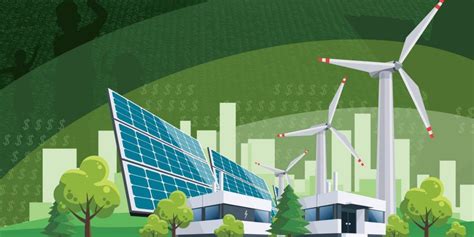Understanding Green Technology
Green technology, also known as environmental technology or clean technology, refers to the development and application of products, services, and processes that promote sustainability and protect the environment. It encompasses various fields such as energy, transportation, waste management, and construction, with the aim of reducing negative impacts on the planet and conserving natural resources. Understanding green technology is crucial in addressing the global challenges of climate change, pollution, and resource depletion.
One of the key aspects of green technology is its focus on using renewable sources of energy. Renewable energy solutions, such as solar power, wind power, and hydropower, harness the natural energy from the sun, wind, and water, respectively, to generate electricity. Unlike fossil fuels, which emit greenhouse gases and contribute to climate change, renewable energy is clean and sustainable. By embracing renewable energy sources, we can decrease our dependence on non-renewable resources and minimize our carbon footprint.
Another important component of green technology is the adoption of energy-efficient practices and technologies. Energy efficiency involves using less energy to perform the same tasks or achieving the same results. This can be achieved through the use of energy-efficient appliances, LED lighting, insulation, and smart energy management systems. By reducing energy consumption, we can decrease greenhouse gas emissions and save money on energy bills. Energy efficiency not only benefits the environment but also promotes economic growth and improves energy security.
In addition to addressing energy-related issues, green technology also plays a significant role in waste management. Innovations in waste-to-energy technologies, recycling processes, and eco-friendly materials have revolutionized the way we deal with waste. Green technology aims to minimize waste generation, promote recycling and composting, and recover valuable resources from waste streams. By implementing sustainable waste management practices, we can reduce landfill space, conserve resources, and minimize pollution.
- Renewable energy solutions
- Energy efficiency
- Waste management
Green technology is not limited to a single industry or sector. It is a multidisciplinary approach that requires collaboration and innovation from various stakeholders, including governments, businesses, and individuals. Governments can support green technology through policies and incentives that promote renewable energy, energy efficiency, and sustainable practices. Businesses can integrate green technology into their operations by adopting sustainable manufacturing processes, reducing emissions, and promoting eco-friendly products. Individuals can contribute to green technology by making conscious choices, such as using public transportation, recycling, and conserving water and electricity.
| Benefits of understanding green technology: |
|---|
| Reduced carbon footprint |
| Conservation of natural resources |
| Improved air and water quality |
| Enhanced energy security |
| Economic growth and job creation |
In conclusion, understanding green technology is essential for creating a sustainable and greener future. By embracing renewable energy solutions, improving energy efficiency, and adopting eco-friendly practices, we can mitigate the environmental impact of our actions and preserve the planet for future generations. Green technology presents opportunities for innovation, economic growth, and a healthier planet. It is up to us to embrace and support these technological advancements in our pursuit of a more sustainable world.
The Environmental Impact of Green Technology
The Environmental Impact of Green Technology
Green technology, also known as clean technology, refers to the use of environmentally friendly materials and practices to reduce the negative impact on the environment. As the world becomes more aware of the consequences of climate change and the need for sustainable development, the importance of green technology is becoming increasingly evident. This article explores the environmental impact of green technology and how it is shaping the future of industries and everyday life.
One of the key benefits of green technology is its ability to reduce carbon emissions. Traditional energy sources such as fossil fuels contribute significantly to greenhouse gas emissions, which are major drivers of climate change. Green technology aims to shift from these non-renewable energy sources to cleaner alternatives like solar, wind, and hydropower. By harnessing these renewable energy sources, we can significantly reduce carbon emissions and combat climate change.
In addition to reducing carbon emissions, green technology also plays a significant role in waste management. As industries and households generate tremendous amounts of waste each day, it is crucial to find sustainable solutions that minimize the environmental impact. Green technology offers innovative methods of waste management, such as recycling and composting, which help divert waste from landfills and reduce pollution. These practices not only conserve natural resources but also promote a circular economy where waste is seen as a valuable resource.
Moreover, green technology promotes sustainable design and green building practices. Buildings consume a substantial amount of energy and contribute to carbon emissions. However, by incorporating energy-efficient materials, utilizing natural resources, and utilizing smart building systems, green technology can significantly reduce the environmental footprint of buildings. These sustainable design practices not only benefit the environment but also improve the health and well-being of occupants.
- Green technology reduces carbon emissions
- Green technology plays a significant role in waste management
- Green technology promotes sustainable design and green building practices
Green technology is revolutionizing various industries and lifestyles as it brings about a positive environmental impact. By embracing green technology, we can create a sustainable future that balances economic growth with environmental stewardship. It is essential for individuals, businesses, and governments to adopt and support green technology to mitigate climate change, preserve natural resources, and protect our planet for future generations.
Reducing Carbon Footprint with Green Technology
Green technology, also known as clean technology, is a term used to describe the use of environmentally friendly and sustainable practices in various industries. It focuses on reducing the carbon footprint, which is the amount of carbon dioxide and other greenhouse gases emitted into the atmosphere by human activities. The goal is to minimize the negative impact on the environment and create a more sustainable future for generations to come.
One of the main reasons why green technology is vital in reducing carbon footprint is its focus on renewable energy sources. Traditional energy sources such as fossil fuels release significant amounts of carbon dioxide when burned for electricity or transportation. On the other hand, renewable energy sources like solar, wind, and hydroelectric power produce little to no emissions, making them a cleaner alternative.
Another way green technology helps reduce carbon footprint is through energy-efficient practices. This includes using energy-efficient appliances, insulation, and lighting in homes and buildings. By minimizing energy wastage, less electricity is needed, leading to a decreased demand for fossil fuel-powered electricity generation. This, in turn, reduces carbon emissions from power plants.
- Use renewable energy sources: Investing in solar panels or wind turbines for generating electricity can significantly reduce your reliance on fossil fuels.
- Embrace energy-efficient appliances: Replacing old, energy-consuming appliances with energy-efficient ones can result in significant energy savings.
- Adopt sustainable transportation: Consider using public transportation, cycling, or walking whenever possible to reduce carbon emissions from vehicles.
| Advantages of Green Technology in Reducing Carbon Footprint | Disadvantages of Green Technology in Reducing Carbon Footprint |
|---|---|
| – Helps combat climate change- Reduces air pollution- Promotes sustainable practices- Can lead to cost savings in the long run | – Initial high costs of implementing green technology- Limited availability in certain regions- Requires investment in new infrastructure |
Renewable Energy Solutions for a Greener Future
There is no denying the fact that renewable energy solutions are the key to a greener future. With the world facing the consequences of climate change and the depletion of traditional sources of energy, it has become imperative to shift towards sustainable and eco-friendly alternatives. Renewable energy, also known as green energy, refers to the energy generated from sources that are naturally replenished, such as sunlight, wind, water, and geothermal heat. In this blog post, we will explore the importance of renewable energy and discuss some of the most effective solutions for a greener future.
The Environmental Impact of Renewable Energy
Renewable energy sources have gained significant attention due to their minimal environmental impact compared to fossil fuels. Burning fossil fuels releases harmful greenhouse gases into the atmosphere, leading to global warming and climate change. On the other hand, renewable energy sources, such as solar and wind power, produce little to no greenhouse gas emissions. By transitioning to renewable energy, we can reduce our carbon footprint and mitigate the adverse effects of climate change.
Top Renewable Energy Solutions
1. Solar Power: Solar energy is harnessed by using photovoltaic cells to convert sunlight into electricity. The installation of solar panels on rooftops and in large solar farms has become increasingly common. Solar power is a clean, abundant, and renewable source of energy that can be utilized for various purposes, including residential, commercial, and industrial.
2. Wind Power: Wind turbines generate electricity by harnessing the kinetic energy of the wind. This form of renewable energy is particularly effective in areas with consistent wind patterns. Wind farms, consisting of multiple wind turbines, are deployed to produce large-scale renewable energy and contribute to the power grids.
3. Hydropower: Hydropower is generated by capturing the energy of flowing or falling water. Dams and water turbines are utilized to convert the energy into electricity. Hydropower is a reliable and widely used form of renewable energy that can also provide energy storage capabilities through pumped storage.
List of Other Renewable Energy Solutions:
| Renewable Energy Solution | Description |
|---|---|
| Biomass Energy | Energy obtained from organic materials, such as wood, crop residues, and waste, through combustion or conversion processes. |
| Geothermal Energy | Energy extracted from the heat stored within the Earth’s core and used for heating, cooling, and electricity generation. |
| Tidal Energy | Energy harnessed from the tidal movements of oceans and seas, converting it into electricity through tidal barrages or tidal turbines. |
| Wave Energy | Energy captured from the motion of ocean waves and transformed into electricity using wave energy converters. |
| Hydrogen Energy | Energy produced by utilizing hydrogen gas, which can be obtained through various methods, including water electrolysis. |
As we embrace renewable energy solutions, we not only reduce our reliance on non-renewable resources but also promote a cleaner and healthier environment. Governments, corporations, and individuals must come together to invest in and support the development of renewable energy technologies. By making the shift towards a greener future, we can ensure a sustainable planet for future generations.
Green Building Practices and Sustainable Design
Green building practices and sustainable design are essential components of creating a greener and more sustainable future. With increasing concerns about the environment and the need to reduce carbon emissions, the construction industry is embracing eco-friendly practices to minimize its impact on the planet. Sustainable design encompasses various aspects, including energy efficiency, water conservation, use of recycled materials, and promoting a healthy indoor environment. By incorporating these practices into the construction and design of buildings, we can create spaces that are not only environmentally friendly but also contribute to the well-being of occupants.
One of the key elements of green building practices is energy efficiency. This involves using energy-efficient materials and design techniques that aim to reduce the reliance on traditional energy sources. By utilizing insulation, advanced glazing systems, and efficient HVAC (heating, ventilation, and air conditioning) systems, buildings can significantly reduce their energy consumption. Additionally, incorporating natural daylight and efficient lighting systems can further decrease the reliance on artificial lighting, reducing energy usage and costs.
Another important aspect of sustainable design is water conservation. The construction industry is increasingly using innovative technologies and strategies to minimize water usage in buildings. Implementing rainwater harvesting systems, low-flow fixtures, and efficient irrigation systems can help reduce water consumption and preserve this valuable resource. Additionally, incorporating native plants in landscaping designs can reduce the need for excessive watering, pesticides, and fertilizers, promoting a healthier ecosystem.
- Energy efficiency
- Water conservation
- Use of recycled materials
- Promoting a healthy indoor environment
| Benefits of Green Building Practices and Sustainable Design: |
|---|
| Reduced energy consumption and lower utility costs. |
| Improved indoor air quality and occupant health. |
| Conservation of natural resources and reduction of waste. |
| Lower carbon footprint and contribution to climate change mitigation. |
Furthermore, the use of recycled and sustainable materials in building construction is gaining popularity. Choosing materials that have a low environmental impact, such as reclaimed wood, recycled steel, and sustainable flooring options, can help reduce the depletion of natural resources and minimize waste generation. Incorporating these materials not only contributes to sustainable practices but also adds aesthetic value to the buildings.
Lastly, sustainable design takes into consideration the well-being and health of building occupants. By using non-toxic and eco-friendly materials, designing spaces that promote natural ventilation and incorporating biophilic design principles, green buildings create healthier indoor environments. These practices have been shown to enhance productivity, reduce stress, and improve overall physical and mental well-being.
In conclusion, green building practices and sustainable design play a crucial role in creating a more sustainable future. By incorporating energy-efficient systems, promoting water conservation, using recycled materials, and prioritizing occupant health, we can construct buildings that have a minimal impact on the environment and contribute positively to the overall well-being of society. Embracing these practices not only benefits us in the present but also ensures a greener and healthier future for generations to come.
Smart Grid Technology: Revolutionizing Energy Management
Smart grid technology is revolutionizing the way we manage energy. It is an advanced energy infrastructure that utilizes digital communication and smart meters to monitor and control electricity consumption in real-time. This technology allows for two-way communication between the utility company and consumers, enabling a more efficient and reliable electrical grid.
One of the key benefits of smart grid technology is that it enhances energy management. With traditional grids, utilities have limited visibility into the energy usage patterns of individual consumers. However, smart grid technology provides detailed and real-time data on energy consumption, allowing consumers to make more informed decisions about their electricity usage. This information can help consumers identify areas where they can minimize energy waste and reduce their overall energy consumption.
Moreover, smart grid technology enables demand response programs, where utilities can incentivize consumers to reduce their energy usage during peak demand periods. This helps to alleviate strain on the electrical grid during times of high demand, reducing the risk of blackouts and improving overall grid reliability. Through real-time data and demand response programs, smart grid technology empowers consumers to actively participate in energy management and contribute to a more sustainable energy future.
In addition to enhancing consumer-level energy management, smart grid technology also provides benefits at the utility level. The technology enables utilities to monitor the grid more effectively, detecting and addressing issues such as power outages or equipment failures in a more timely manner. This improves the overall reliability of the electrical grid and reduces the duration of power outages.
Furthermore, smart grid technology enables a more effective integration of renewable energy sources into the grid. As the use of renewable energy, such as solar and wind power, continues to grow, it poses challenges to the stability and reliability of the electrical grid. However, smart grid technology can dynamically adjust the energy flow, ensuring a smooth integration of renewable energy sources and maximizing their potential contribution to the overall energy mix.
In conclusion, smart grid technology is revolutionizing energy management by providing real-time data, enabling demand response programs, improving grid reliability, and facilitating the integration of renewable energy sources. The implementation of smart grid technology not only benefits consumers by empowering them to actively manage their energy usage but also enhances the overall efficiency and sustainability of the electrical grid. As we strive for a greener and more sustainable future, smart grid technology plays a crucial role in revolutionizing energy management.
The Role of Green Technology in Waste Management
Green technology plays a crucial role in waste management, contributing to the preservation of the environment and the efficient utilization of resources. Waste management involves the collection, transportation, treatment, and disposal of waste materials. Traditional waste management methods often lead to environmental degradation and contribute to the release of harmful pollutants into the air, water, and soil. However, with the emergence of green technology, innovative solutions have been developed to minimize the adverse impacts of waste on ecosystems and human health.
One important aspect of green technology in waste management is the adoption of recycling practices. Recycling involves the collection and processing of various waste materials to create new products. Through recycling, the consumption of raw materials is reduced, which helps to conserve natural resources and reduce energy consumption. Plastics, paper, glass, and metal are some of the commonly recycled materials. Recycling not only diverts waste from landfills but also reduces greenhouse gas emissions, promoting a more sustainable waste management system.
Another way green technology contributes to waste management is through the implementation of sustainable waste treatment methods. Traditional waste treatment methods, such as incineration and landfilling, can have harmful environmental consequences. Incineration releases toxic pollutants into the air, while landfilling can contaminate groundwater and emit greenhouse gases. Green technology offers alternative solutions such as composting, anaerobic digestion, and thermal depolymerization. These methods convert waste into valuable resources such as organic fertilizers, biogas, and renewable energy. By utilizing these sustainable waste treatment methods, the environmental impact of waste disposal is minimized.
In addition to recycling and sustainable waste treatment, green technology also plays a role in waste reduction and prevention. By promoting awareness and providing incentives for waste reduction, green technology encourages individuals and businesses to adopt environmentally friendly practices. This includes measures such as source reduction, where waste generation is minimized at the point of production. Green technology also emphasizes the importance of designing products that are easily recyclable or biodegradable, reducing the amount of waste generated in the first place. Through waste reduction and prevention strategies, green technology contributes to a more sustainable waste management system.
- Recycling: diverts waste from landfills and conserves natural resources.
- Sustainable waste treatment: converts waste into valuable resources and reduces environmental impact.
- Waste reduction and prevention: promotes environmentally friendly practices and minimizes waste generation.
| Benefits of Green Technology in Waste Management |
|---|
| 1. Environmental preservation and conservation of natural resources. |
| 2. Reduction of greenhouse gas emissions and air pollution. |
| 3. Minimization of harmful impacts on ecosystems and human health. |
| 4. Promotion of a circular economy and sustainable development. |
| 5. Creation of green jobs and economic opportunities in the waste management sector. |
Innovative Green Transportation Solutions
Transportation is a crucial aspect of our daily lives, allowing us to travel from one place to another with convenience. However, the traditional modes of transportation often contribute to pollution and traffic congestion, resulting in adverse effects on the environment and our overall well-being. This is where green transportation solutions come into play, offering innovative and sustainable alternatives that aim to reduce the environmental impact of transportation.
One of the most innovative green transportation solutions is the incorporation of electric vehicles (EVs). EVs are powered by batteries that store electricity, eliminating the need for fossil fuel consumption and reducing harmful emissions. With advancements in technology, EVs are becoming more accessible and affordable, making them a viable option for eco-conscious individuals. Additionally, the development of charging infrastructure and increased battery capacity have addressed the issue of limited range, making them a practical choice for everyday commuting.
Another green transportation solution gaining traction is the concept of shared mobility. Shared mobility services such as ride-sharing, carpooling, and bike-sharing aim to optimize transportation resources by maximizing vehicle occupancy and minimizing the number of vehicles on the road. By encouraging people to share rides or utilize shared transportation options, we can significantly reduce traffic congestion and exhaust emissions. Furthermore, shared mobility services often incorporate green technologies, such as electric vehicles or bicycles, further contributing to a cleaner and more sustainable transportation system.
- Electric vehicles (EVs)
- Shared mobility
- Cycling infrastructure
| Advantages of Innovative Green Transportation Solutions | Disadvantages of Traditional Transportation |
|---|---|
| Reduced air pollution and greenhouse gas emissions | High levels of air pollution and greenhouse gas emissions |
| Improved energy efficiency | Low energy efficiency |
| Less traffic congestion | High levels of traffic congestion |
| Promotion of active and healthy lifestyles | Sedentary lifestyles and lack of physical activity |
By embracing innovative green transportation solutions, we can significantly reduce the negative environmental impact associated with traditional transportation systems. Not only do these solutions help combat climate change by reducing greenhouse gas emissions, but they also promote healthier and more active lifestyles. It is essential for individuals, communities, and policymakers to support and invest in these sustainable transportation solutions to create a greener and more sustainable future for all.
Frequently Asked Questions
Q: How does green technology reduce carbon footprint?
Green technology reduces carbon footprint by utilizing renewable energy sources and implementing energy-efficient practices, such as energy-saving appliances, LED lighting, and smart heating and cooling systems. These technologies help reduce greenhouse gas emissions and dependence on fossil fuels, thus mitigating the impact of climate change.
Q: What are some examples of renewable energy solutions?
Examples of renewable energy solutions include solar power, wind power, hydropower, geothermal energy, and biomass energy. These sources of energy are sustainable and can be replenished naturally, making them environmentally friendly alternatives to fossil fuels.
Q: How do green building practices contribute to sustainable design?
Green building practices promote sustainable design by incorporating energy-efficient features, using eco-friendly building materials, implementing water conservation measures, and prioritizing indoor environmental quality. These practices help minimize the environmental impact of buildings throughout their lifecycle, from construction to operation and eventual demolition or renovation.
Q: How does smart grid technology revolutionize energy management?
Smart grid technology revolutionizes energy management by enabling real-time monitoring, control, and optimization of energy generation, distribution, and consumption. This technology facilitates efficient energy use, improves reliability and resilience of the power grid, and integrates renewable energy sources effectively, allowing for a more sustainable and decentralized energy system.
Q: What role does green technology play in waste management?
Green technology plays a crucial role in waste management by promoting the adoption of eco-friendly waste treatment and recycling methods. This includes technologies like waste-to-energy conversion, composting, anaerobic digestion, and advanced recycling processes. By reducing the amount of waste sent to landfills and maximizing resource recovery, green technology helps minimize the environmental impact of waste disposal.
Q: What are some innovative green transportation solutions?
Some innovative green transportation solutions include electric vehicles (EVs), hydrogen-powered vehicles, biofuels, and improved public transportation systems. These technologies aim to reduce reliance on fossil fuel-powered vehicles, decrease air pollution, and mitigate the carbon emissions associated with transportation.
Q: How does green technology contribute to a greener future?
Green technology contributes to a greener future by addressing environmental challenges through sustainable practices, renewable energy solutions, and efficient resource utilization. By promoting eco-friendly alternatives and reducing reliance on non-renewable resources, green technology paves the way for a more sustainable and environmentally conscious society.





